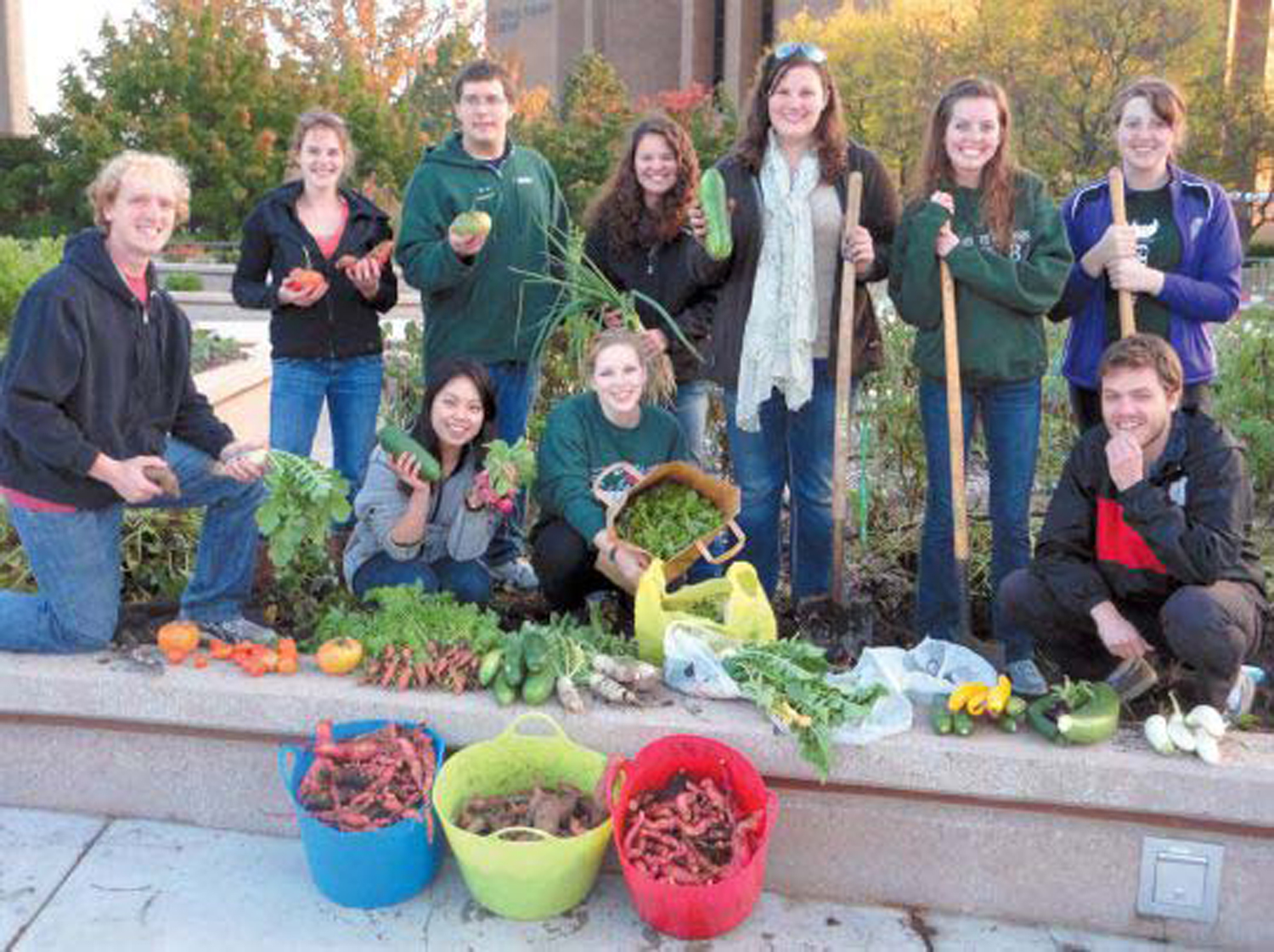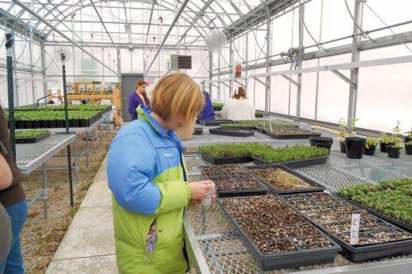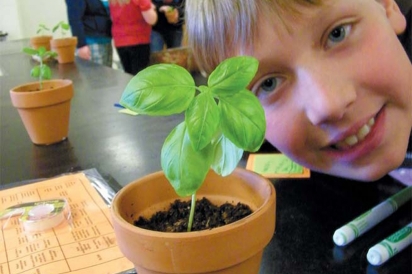Putting Learning into Action
School gardens are hands-on learning labs for all ages and schools
Grant Weber, a first-grader at Southern Door Elementary School, thought planting an onion in the Southern Door Schoolyard Garden was “cool” because he got to put a big scoop of worm castings in the hole with the bulb. Weeding the garden in summer with his mom, Jennifer Weber, was not his favorite but she reports that he was a good helper and they both enjoyed getting in touch with where their food comes from.
“We thought it would be exciting to see the growing process and be responsible for living things. It’s important to see where food comes from — to see it, understand it, and value it,” said Jennifer.
Elementary and middle schools as well as high schools and college campuses around Northeastern Wisconsin are integrating gardens and agricultural learning into their footprint and culture, providing hands-on learning about food from seed to table.
At Southern Door the Schoolyard Garden is an outdoor classroom positioned alongside the playground with vegetables, herbs, flowers, and even cold-hardy seedless table grapes.
“The students are so excited about the Schoolyard Garden. Every chance they get, they explore what is growing and they even get to taste fresh herbs or tomatoes with volunteers,” said Schoolyard Garden cochair Wendy Rivkin.
High school Horticulture students mentor fourth graders to start seedlings in the school’s greenhouse, which are then planted in the spring by elementary students.
“The garden is an extension of what we are doing in the classroom. It fits our curriculum and it is what we want them to do in life — go out and whether it is people, plants, or animals, take care of things,” said Cathy Severson, Southern Door Elementary second grade teacher. “It has been a really positive influence on the students.”
Emphasizing the seed-to-table food cycle, volunteers provide tasting events each fall where fresh, dehydrated and cooked vegetables grown in the garden are served up in samples of soup, cookies, salsas and more.
“The students love the tasting and say they never knew these things tasted so good,” Severson said. “Then they take the recipes home so they can make them with their parents.”
“It brings the mission of the garden and all of the work of the volun- teers and students together,” Rivkin said.
Gardens growing more than food
Schools of higher learning are also getting into the school garden spirit. At the University of Wisconsin-Green Bay (UWGB), garden plots and research greenhouses are tucked around the campus, including a courtyard garden in Mary Ann Cofrin Hall showcasing heirloom plants, a green roof garden and a flax garden grown so students can grow and process flax into linen using ancient methods. The SLOfood (sustainable, local and organic) Alliance garden, located in the plaza outside the Student Union, is the only plot growing food to feed others and is maintained by students.
“The students were passionate about having food growing where people can see it so that people start making the connection between what is on their plate and where it came from,” said Michael Stearny, Dean of Enrollment Services.
The students start the seedlings, plant the garden and maintain it throughout the summer. In June, they open a weekly produce stand on campus.
“It has grown to be more than a garden. The garden is the centerpiece ... but SLOfood Alliance has the other pieces around it that make its focus much more than just about growing food,” Stearny said
SLOfoods Alliance encompasses environmental and sustainability issues with a mission to cultivate, educate and advocate. It organizes a food-focused educational film series in April and advocates for local food sourcing and more organic food options on campus.
A vibrant school garden is tucked into the campus of Lawrence University in Appleton. SLUG (Sustainable Lawrence University Gar- dens) is a student-run, self-sustainable project. Established in 2005 after an Urban Agriculture class completed a feasibility study, SLUG now consists of a honeybee apiary, orchard and quarter-acre garden with a 90-foot hoop house.
Each year about 150 volunteers work at SLUG. In the summer, three managers and a paid intern maintain the garden, reimbursed from produce sales. Produce grown in the garden is sold to the on-campus food service provider.
“To see the work and passion the people in the dining service have for what we grow is really rewarding. They really appreciate the food that we are growing — and the students love it, too,” said Polly Dalton, SLUG co-manager.
Students have taken the initiative to advance SLUG projects. To create its honeybee apiary, students worked with the City of Appleton to adapt an ordinance to allow beekeeping on public and institutionally-owned land such as community gardens and schools. And, all pre-consumer food waste is taken directly from the campus kitchen to be composted for the garden — about a ton of waste per week. Several downtown businesses, such as Aspen Coffee, Harmony Café and Stone Cellar Brew Pub, also participate in the composting project.
A modest fruit orchard of apple, pear and peach trees was a future-forward gift from past students as the first fruit was harvested last fall.
“It was very rewarding ... to see the actual fruits of our labor and the long-term investments of students from other years,” Dalton said. “We are all aware of our history ... and it really inspires us to keep moving forward and to improve on what we are already doing. It is putting learning into action.”
From Floriculture to Aquaponics
Three Green Bay School District High Schools — East, Southwest, and Preble — use greenhouses for hands-on student learning. The agriculture teachers have farm experience and are excited to teach their urban students about the food cycle.
“A greenhouse is like an indoor farm. It offers a different perspective and a unique teaching laboratory for our students,” said Betty Krcma, Agriscience/Natural Resources teacher at Preble.
In floriculture class, students grow flowering bedding plants and vegetables from seed or cuttings for the annual May plant sale; proceeds benefit FFA programs. In late summer, they grow poinsettias. Students enjoy being involved in the growing process from seed to sale. “The students start to see the plants come up in the plant trays and they get so excited. They take out their camera phones and take pictures of them — almost like a growing log,” said Krcma.
In addition to a greenhouse, Green Bay East has an outdoor land lab with 10 species of trees. Mark Strohschein, Agriscience/Natural Resources instructor at East, said the school recently received a grant to develop a composting system using cafeteria food waste and vermiculture — worms — to create soil for the greenhouse.
At Southwest, students learn about aquaponics — a food production system that combines raising fish (aquaculture) — with growing plants in water (hydroponics).
Students grow trout, walleye, blue gill, yellow perch, tilapia and channel catfish and document the rate of gain, effect of water temperatures and pH levels of the water. Tom Sebranek, Agriscience teacher at Southwest, is adding a vertical aquaponics system to his classroom this spring.
“I used to be a dairy farmer; now this has become my farm,” Sebranek said. “I want to be able to show my students that it is possible to do a Farm-to-Food initiative.”








